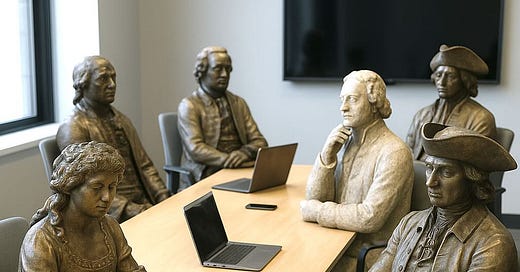You Will Change. Your Strategy Should Too: The End of History Illusion
5 Strategic Thinking Biases I Suffered From as a CEO — and How I Help Others Avoid Them. Part 4
We know the world is changing. But we forget we’re part of the world, too.
If I asked you: “Have you changed over the past 10 years? Have your views, values, and priorities changed?”—you’d most likely say yes.
But if I asked you: “Will you transform over the next 10 years?”— you’d most likely say no.
Scientists called this cognitive bias “the end of history illusion.” Apparently, we believe we've already reached perfection — so why bother trying to change?
If you asked me to name the top 10 cognitive biases in business strategy, this one would be near the top. Missing this is like skipping the foundation when building a skyscraper. And yet we all do it — I was no exception.
The evolution of my strategy
When we’re crafting a strategy, we try to anticipate many types of change:
– In the market
– In competition
– In technology
But what we often miss is that we ourselves will change — and that will affect our strategy, too.
In 2007, I stubbornly believed that the only purpose of business was to make a profit. If you told me there could be any other goal, I’d laugh in your face. My company’s three-year strategy was as simple as a shopping list: if it increased profit, it was good — if it didn’t, it was bad.
In 2008, our revenue plummeted by almost 40%. It turned out that the value we offered didn’t match all our customers’ needs. That experience taught me to pay much closer attention to our customers. I shredded the old strategy, and we started over.
In 2009, my CFO came up with a new bank-backed factoring financing scheme for our client deals. It allowed us to offer customers extended payment terms — and it changed the market.
In 2011, I studied corporate governance — and we revamped our governance system. In 2013, I focused on foresight — and we shifted to a foresight-driven strategy.
Every new book I read and every training course I took refined my worldview—and, in turn, our strategy.
The more I embraced the mindset of a student — even as a CEO — the stronger our strategy became.
Every time I walked into the office with a new idea, my team would groan and roll their eyes. Sometimes the ink hadn’t even dried on the old strategy before I started working on the next one. But every time, I convinced the team the new version would be better — and it always turned out to be true.
If you’re a business leader, you have to evolve fast.
A team can’t grow faster than its leader. A company can’t grow faster than its leadership team.
But if you grow, your strategy grows with you.
Many compare strategy to a map — but that’s a mistake. A map is made by someone else.
You make your strategy. It doesn’t just chart the route — it reshapes the terrain.
And the more you grow, the bolder the changes you make to the world around you. Knowledge broadens your repertoire of tools and solutions.
For instance, in 2010, I worked in a country where broadband internet access was still years away. Key players of our industry believed the Internet would never reach their backwaters.
But I visited a few internet companies and studied their models. I found a way to adapt some of their concepts to our market. The models we built in 2011 are still in use today.
Only 3 days left to get the book at a special price! See the end of the article for details.
Conclusion: How Not to Drown in Endless Strategy Updates
If your strategy is two years old, and you believe it’s still relevant, you might have missed something.
The concept of a strategy as something you develop once and don't touch in three to five years is obsolete. Don’t be afraid to shake up your strategy once a year. Even if you find it’s still relevant — it’s a worthwhile exercise either way.
But if your strategy becomes too flexible, it means you have no strategy.
I use this simple technique when I help my clients develop their strategies:
1. We build strategies around answers to all 25 strategic questions. But we avoid getting lost in the details.
2. We outline the critical processes and assets required to execute the strategy.
3. The business stays flexible across all processes and assets — except those on the list.
So, no — our strategy isn't just the CEO's latest whim inspired by a book they read last night.
We know exactly which processes and assets we can safely improvise with — and which ones we'll leave untouched unless something truly radical happens.
Need help figuring this out in your company? Drop me a line — happy to help.
––
This is one of a series of articles on paradoxes in business strategy and cognitive biases in strategic thinking that explain why strategic plans fail.
Read the rest of the articles here, here, here, here, here, and here.
You can get the e-book here and the audiobook here. The special offer price is valid only until July 11.
But that’s not your only option — the book is also available on Amazon (in print or digital form) or at your favorite online bookstore.
This morning, my Strategic Seeing newsletter reached 4,000 subscribers. Thank you for your support!
Svyatoslav Biryulin
––
Subscribe to this newsletter where I explore strategic thinking traps and strategic decision making errors — and how to develop a successful strategy.






Very interesting!
Love the part on a business cannot grow faster than its leadership team.